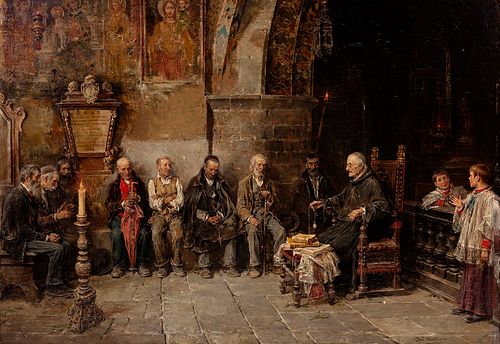JOSÉ BENLLIURE GIL (Valencia, 1855 - 1937). "The beggars, Basilica of Assisi". Oil on panel.
Lot 82
About Seller
Setdart Auction House
Carrer Aragó 346
Barcelona
Spain
Setdart Subastas was born in 2004 and is currently the first online art auction in Spain with solidity, prestige and reliability guaranteed by our more than 60,000 users. Setdart has a young, dynamic and enterprising team ready to successfully manage the purchase and sale of art works through custom...Read more
Estimate:
EUR€25,000 - EUR€30,000
$26,881.72 - $32,258.06
Absentee vs Live bid
Two ways to bid:
- Leave a max absentee bid and the platform will bid on your behalf up to your maximum bid during the live auction.
- Bid live during the auction and your bids will be submitted real-time to the auctioneer.
Bid Increments
| Price | Bid Increment |
|---|---|
| EUR€0 | EUR€10 |
| EUR€200 | EUR€25 |
| EUR€500 | EUR€50 |
| EUR€1,000 | EUR€100 |
| EUR€3,000 | EUR€200 |
| EUR€5,000 | EUR€500 |
| EUR€10,000 | EUR€1,000 |
| EUR€20,000 | EUR€2,000 |
| EUR€50,000 | EUR€5,000 |
About Auction
By Setdart Auction House
Nov 10, 2021
Set Reminder
2021-11-10 08:00:00
2021-11-10 08:00:00
America/New_York
Bidsquare
Bidsquare : 19th & 20th Century paintings and Decorative Arts
https://www.bidsquare.com/auctions/setdart-auction-house/19th-20th-century-paintings-and-decorative-arts-7800
Setdart Auction House sofia@setdart.com
Setdart Auction House sofia@setdart.com
- Lot Description
JOSÉ BENLLIURE GIL (Valencia, 1855 - 1937). "The beggars, Basilica of Assisi". Oil on panel. Signed in the lower right corner. Measurements: 37 x 53 cm; 61 x 77 cm (frame). José Benlliure cultivated the costumbrista theme and the portrait. In the present case, we are in front of a scene in the interior of the Basilica of San Francisco de AsÃs. In it, some beggars appear seated on the bench of the basilica under the serious gaze of the parish priest, while praying the rosary. The scene plays with the light and the backgrounds, creating several spaces. The main part of the piece is the one that frames the beggars next to the parish priest, illuminated by a candle; while the secondary scene is played by two altar boys, at the back of the parish priest, who talk to each other. The background of this second scene is almost black. It is not arbitrary that the scene is represented in the Basilica of St. Francis of Assisi, since he went from being the son of a rich merchant of the city in his youth, to live under the strictest poverty and observance of the Gospels. His religious life was austere and simple, so he encouraged his followers to do the same. In short, we find a piece with exceptional detail, where each face, each architecture and each detail are worked to the millimeter. José Benlliure began his artistic studies with Francisco Domingo in Valencia, to later continue his training in Madrid, where he settled in 1869. From an early age he enjoyed the patronage of the King of Savoy and in 1879 he moved to Rome, where he was discovered by the important art dealer Martin Colnaghi, who financed his studies in the city. In 1897 he made several trips to Tangier, Algeria and Morocco where he approached through a realistic, luminous and loose painting to the daily world of the places visited. From 1900 onwards his work depicts popular themes. He took part in the National Exhibitions of Fine Arts, obtaining third medals in the editions of 1876 and 1878 and first in 1887. He belonged to the Academies of San Fernando (Madrid), San Lucas (Rome), San Carlos (Valencia), Brera (Milan) and Munich. Between 1904 and 1912 he directed the Spanish Academy in Rome. The most important part of his production is preserved in Valencia, in his House Museum and in the Museum of Fine Arts San PÃo V. He is also represented in the Prado Museum, the Thyssen-Bornemisza and the Palace of Charles V in Granada, among others.
- Shipping Info
-
In-house shipping available. Please inquire at admin@setdart.com.
-
- Buyer's Premium



 EUR
EUR CAD
CAD AUD
AUD GBP
GBP MXN
MXN HKD
HKD CNY
CNY MYR
MYR SEK
SEK SGD
SGD CHF
CHF THB
THB

















